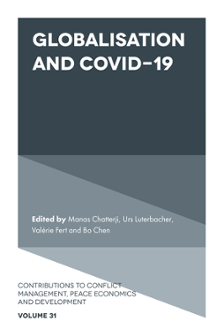
Index
ISBN: 978-1-80262-532-5, eISBN: 978-1-80262-531-8
ISSN: 1572-8323
Publication date: 10 July 2023
Citation
(2023), "Index", Chatterji, M., Luterbacher, U., Fert, V. and Chen, B. (Ed.) Globalisation and COVID-19 (Contributions to Conflict Management, Peace Economics and Development, Vol. 31), Emerald Publishing Limited, Leeds, pp. 183-191. https://doi.org/10.1108/S1572-832320230000031012
Publisher
:Emerald Publishing Limited
Copyright © 2023 Manas Chatterji, Urs Luterbacher, Valérie Fert and Bo Chen
INDEX
(see also Disaster management)
(see also Conflict management)
- Prelims
- Chapter 1: Regional Science, Peace Science, and Analytical Management Research Techniques in COVID-19 in the Developing Countries
- Chapter 2: International Relations and Global Climate Change
- Chapter 3: COVID-19 and Public Debt
- Chapter 4: Smart Governance Under COVID-19 Pandemics: Strategic Endeavours Towards Sustainability Made by Local Communities in Japan
- Chapter 5: The COVID Crisis and a New Industrial Strategy for Europe
- Chapter 6: Cold Peace in a Less Globalised and Heating World
- Chapter 7: Some Crucial and Major Changes in a Post-COVID-19 World as Seen by the AI System Mileva
- Chapter 8: How the COVID-19 Pandemic Probably Accelerated CSR Global Awareness
- Chapter 9: Five Reasons Why the COVID-19 Crisis is Related to National Security and Arms Control
- Chapter 10: Incorporating Cultural Heritage Destruction in Conflict and Peace Economics
- Chapter 11: Ghost Wars: The Art of Hybrid Warfare in the 21st Century: The Case of Russia and China
- Index